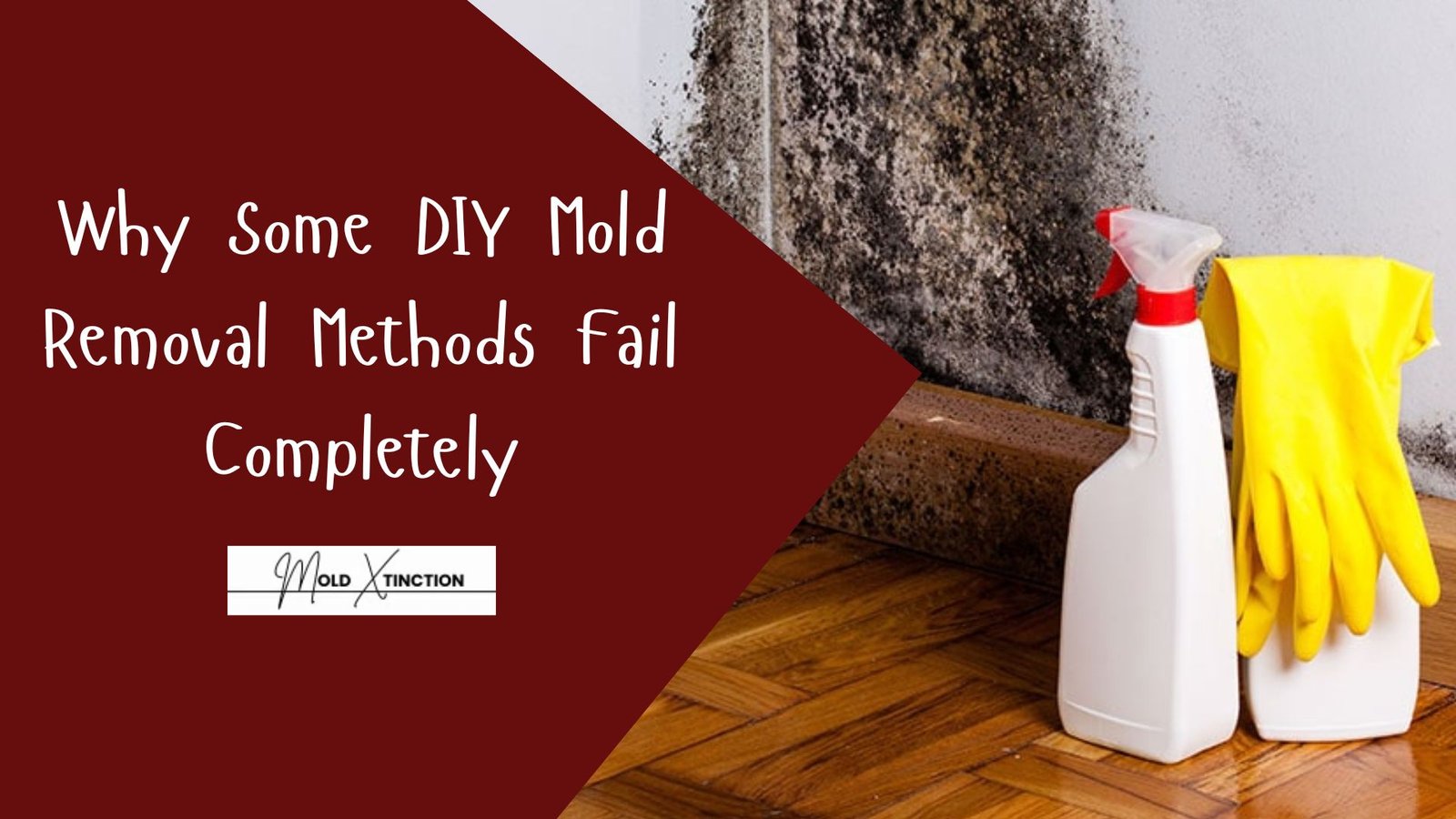There are so many reasons why some DIY mold removal methods fail completely. You need to know why and how, so you know the best approach to take so that yours can be successful.
DIY Mold Removal Methods are those that you do yourself to get rid of the mold without consulting a mold removal professional. Maybe you grab bleach, vinegar, or baking soda from the kitchen.
Maybe a sponge on the walls, a squirt of cleaner, a window open. It seems like you’re so you get a temporary feeling that you’re solving the problem, and it may even look better.
But the point is, most of what you do is only clean what you can see. The mold is behind the walls, wood surfaces, and other materials. With special tools or training, you may not even notice the real issue.
What’s worse is you may be introducing mold spores into your air and throughout your house without even realizing it. So, although DIY methods may seem like a solution, they’re not always effective.
Here in this article, we will tell you why these methods are not worth trying, how they can make things worse, and why calling a professional mold remediation service is always the smart and safe choice.
What's In This Article
ToggleWhy Some DIY Mold Removal Methods Fail Completely

As we go deeper into it, you will see why most DIY molds fail to work as expected.
1. Cleaning is only on the surface
Most try to clean off molds by applying bleach, vinegar, or water with some soap. It may seem like the mold is gone. But the problem is that such methods only clean the surface. The roots of the mold are left behind, and the mold will grow fast again and even spread to other areas.
Mold doesn’t just grow on the outside but also deep within the materials.
Mold can only be cleaned on the surface, and what you can’t see is not cleaned. Yet there’s mold growing somewhere under the paint, wood, or wall. These underground roots keep growing. That’s why the mold comes back after a few days, even worse at times.
2. Mold May be Worsened by Bleach
Most DIY websites suggest killing mold with bleach. Bleach can be used on hard surfaces like tiles or glass. But it can’t penetrate deep into soft and porous materials like wood or dry paper because it will not kill the mold behind the surface. The issue is left behind.
Here’s why:
- There are substances that bleach can’t penetrate, that’s why it will come back, since it’s inside those materials.
- Bleach contains enough water, and it’s mold favorite.
- Once the little chemical content of the bleach finishes the water, it will help to grow more mold as time goes on.
So by using bleach, you’re actually feeding the mold to grow.
3. Vinegar Does Not Fit All Situations
One of the DIYs that people follow in removing mold is vinegar. It’s natural, relatively cheap and finally safe compared to bleach. Although mold can be removed using vinegar, it should be on the surface of the mold and it’s not effective in eliminating deeply rooted/massive mold. It doesn’t eliminate mold stains as well as powerful odors too. So although it may seem that the mold is dead, it may still grow inside and reappear once the favorable conditions emerge.
- It can kill mould, though not all.
- It won’t eliminate mold stains or smell.
- Vinegar is so weak it can’t kill on big surfaces or when heavily infested.
What vinegar will do is slow down its growth, but if you feel it will prevent them, it won’t.
4. Poor removal contaminates mold spores throughout the premises.
You might think you’re cleaning the mold when you scrub it with a sponge or a brush. But what you don’t know is when you wash them, you’re literally blowing thousands of millimeters of mini-mold spores all over the place. The spores you can’t see can find their way through your house and settle in the walls, furniture or even in the ventilation system (air ducts). When they land on a moist place, they start to grow again. This not only spreads the mold but may cause you and your family to have health problems, including breathing issues and allergies etc.
Such spores:
- Floats to other rooms and starts new colonies of moulds
- Get into your air ducts and spread to the whole house
- May cause breathing problems to you and your family
Unless you wear the right safety gear, have the right airflow and containment equipment, what you’re not doing is removing the mold; you’re spreading it.
5. Can’t pick the source of the Moisture
Mold can’t grow in a dry environment but as long as you don’t get rid of the source of the water i.e. the cause of the humidity, the mold will always come back. Mold can grow in leaky pipes, roof damage, poor ventilation or a damp basement. You may clean it but it will grow back if the mouth area is still wet. No amount of cleaning will last if not solved moisture-wise. Mold will never stop where there is water and humidity.
Sources of common moisture are:
- Leaky pipes
- Roof leaks
- Busted AC or humidifiers
- Bad basement or crawl spaces
Most case-handling procedures deal with cleaning the surface but don’t address the root cause so the mold will come back as it’s treated again and again.
6. DIY Approaches Don’t Use Professional Equipment
Some of the equipment these pros use are:
- Seismological vacuum filters that trap mold spores
- Industrial dehumidifiers
- Moisture meters
- Air scrubbers
Most homes don’t have these tools. Without them, you can’t:
- Know how far the mold has spread
- If the mold has reached hidden areas
- If the air can be breathed in again
After you clean the room yourself, there may still be hidden mold in the room even if it looks clean. You may not see or smell it but that doesn’t mean it can’t grow and spread and cause damage and health issues without you knowing it.
7. Unhealthy Conditions of Safety and Health
Mold cleaners have:
- Full body suits
- Gloves
- Eye protection
- Respirator masks
Self-built cleaners walk into the room wearing normal clothes, no mask. This exposes you to:
- Breathing in mold spores
- Rashes on the skin or itchiness on the skin
- Over exposure to toxic chemicals (e.g. black mold)
Mold is toxic to your health as you try to clean it yourself without wearing the right protective gear. A person can experience irritations or allergic reactions like congestion or can even develop serious breathing problems that can be fatal if the mold is toxic or if the area affected is large and you’re exposed to the spores on your skin or by breathing.
8. Small Mold problems can’t be treated at Home
You can treat a small amount of mold in the corner of the bathroom with caution.
But when:
- More than 10 square feet of mold is covered
- You find it in ceilings, walls and floors
- Everywhere you smell that musty smell of old house
… then the mold is more than you can handle yourself.
The size of the mold problem is not something you want to tackle yourself. It requires professionals who understand how to inspect the premises, prevent the spread of growth and eliminate the mold completely. The problem can get bigger and more dangerous over time without expert help.
9. Nobody does Post-Clean Testing
Do you think that when you clean the mod by yourself, the mold has gone?
It can look clean to your eyes but frankly speaking they are still there. It needs to be killed from the root with specail tools and chemicals by an expert.
After cleaning, the air and surfaces are tested to ensure there are no spores left by the professional remediation services. If not, mold can regrow without you knowing.
10. Destroying Your Property
Trying to scrub away mold in the opposite direction, overusing bleach or vinegar, or ripping off sections of your wall can lead to disastrous consequences to your home. You may end up hiring repair experts and paying tens of thousands of dollars to fix broken walls, floors or paint and have mold infestations even worse in the future.
This can result in:
- Crumbling walls and ceilings
- Paint peeling off and rotten wood
- Higher repair costs later
Trying to be economical by dealing with the mold removal on your own may cost more than you think in the long run.
Why You Always Need to Call a Professional Mold Remediation Company
Unless you want to risk your health, your own home and your family’s lives, your best and wisest decision will be to hire a professional mold cleanup service. This gives you peace of mind as they have the right tools, training and experience and of course know how to remove mold completely and make sure it won’t come back.
Here’s what professionals do differently:
- Inspect the entire property to find all mold growth
- Identify what kind of mold it is (some are more dangerous than others)
- Contain the mold so it won’t spread as it is removed
- Remove all mold safely with expert tools and techniques
- Dehumidify the area and make it dry to prevent mold from coming back
- Test the air to make sure it’s safe again
Conclusion
Although DIY mold removal may seem like a cheap and fast solution, it won’t give you the results you want. You can clean only the visible part of the mold but there are others that can grow and spread further and this can be a threat to your home and health. You won’t know how to fix the situation without the right tools, knowledge or protection and make the situation even worse or harm yourself. Mold issue seems small as they look but they are bigger and this is why you should not take chances. The best solution you can think of if you are doubting that the mold has been fully removed and won’t come back again is to call an expert mold removal specialist. Let the experts handle it.
Helpful Guide: What You Should Know Before Hiring a Mold Removal Company


